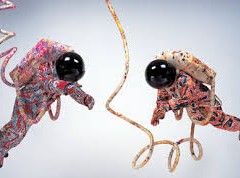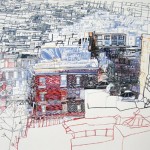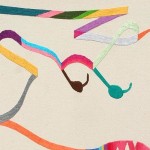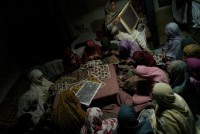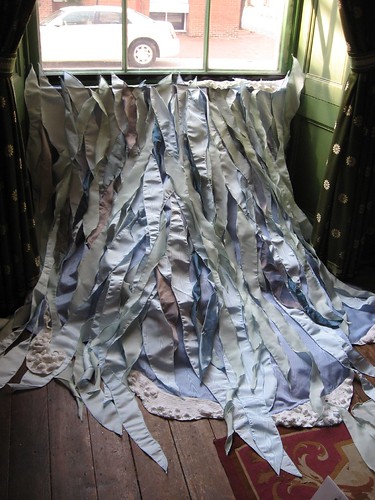
Marie Elcin. Water, Water, Everywhere, detail of the installation which suggests that nature cannot be denied its power by the likes of us
The fabulous fiber exhibits all around town for FiberPhiladelphia are more than even I can take in, and goodness knows, as a fan of fiber, I want to see it all. What’s going on here–a multi-institutional, multi-organizational and multi-gallery cooperative effort–is amazing and overwhelming. This is the first of two posts on the four I did see so far.
And here’s a link to our post, which links to additional listings . There’s so much to see that I count myself lucky I did get to four (in addition to the excellent Susie Brandt exhibit–see Roberta’s post and Andrea’s post; I won’t add to the chatter on that one).
Marie Elcin: Water, Water Everywhere
The Physick House Museum
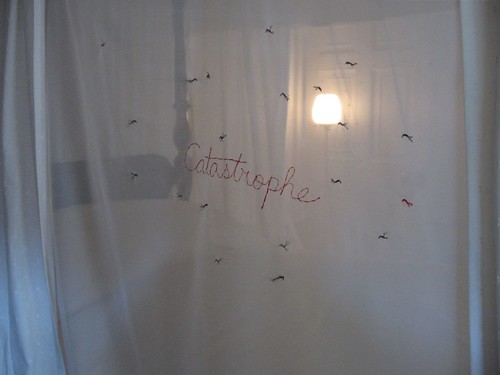
Marie H. Elcin, Water, Water, Everywhere, installation detail of the mosquito netting over the historic house four-poster bed.
The yellow fever epidemic of 1793 killed about 5,000. Marie Elcin’s fiber installation at the Physick House Museum brings water flowing into windows, and mosquitos to a bedroom–in sound and embroidery. Elcin uses the simplest of means to not only bring the past to life, but to tie today’s infrastructure to yesteryear’s and to suggest the possibility of an ensuing disaster as we try to manipulate and develop the landscape. I immediately thought of the Sugar House riparian rights controversy and modern lawsuits about wetlands development.
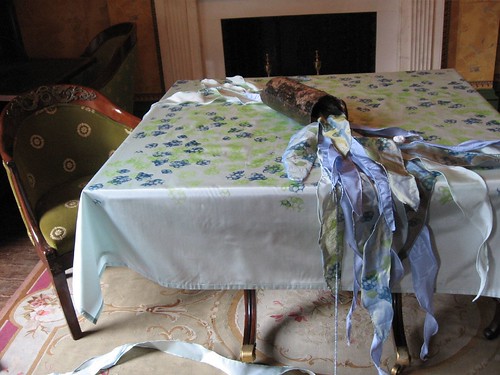
Installation detail of a pipe, one of our ways of trying to control and harness water
Elcin has nailed the importance of our relationship to water, which stagnated in puddles, becoming breeding grounds for the mosquitoes, following a summer drought in the colonial city.
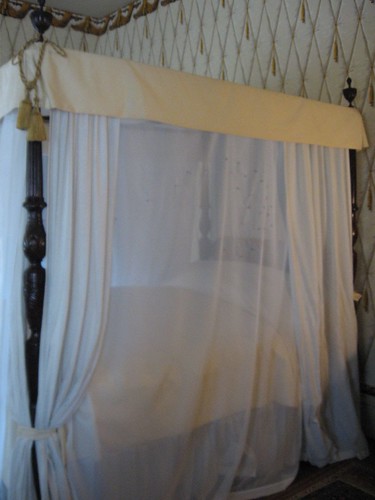
Installation detail, showing the mosquito netting over the four-poster bed
I enjoyed the installation for its wacky embodiment of water downstairs, and its evocative mosquito-embroidered mosquito netting draped over the bed upstairs. The netting expressed the fear that people must have felt at that time (I’m not clear that they knew the role mosquitoes played, but the fear was certainly there). I liked the use of words as well as the sound effects. I also liked the disease theme in the house of a colonial era physician, Dr. Physick. While I was there, a gentleman explained that the good doctor’s name was a corruption of Fishwick, a town in England from whence his people came, and not a reference to his career.
More on Elcin below in the B-Square notes below.
Two installations at the Powel House
Elcin’s yellow fever epidemic killed Philadelphia’s colonial mayor, Samuel Powel, whose house, like Dr. Physick’s, still stands and is a tourist attraction. The Powel House is the site for two other installations.
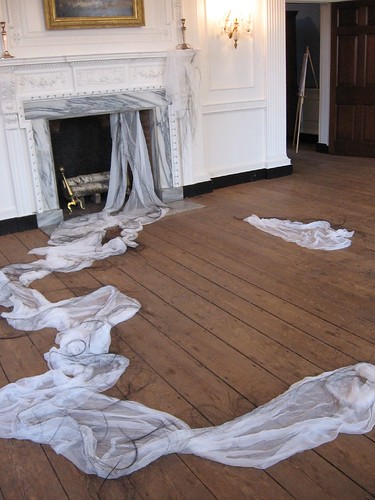
Phuong X. Pham, Stasis, Extended, installation detail
Phuong X. Pham‘s Stasis, Extended installation of white gauzy fabric and knotted horsehair refers to the ghosts of the house and to the house’s use as a horsehair mattress factory, according to the curators notes (by Michelle Wilson and Robert Wuilfe). What seemed most successful to me about the installation was not the horsehair (which seemed to refer more to the artist and her process than to the venue) but the fabric scattered through the ballroom, suggesting both a twirl of dancers as it forces you not to step on it, and also suggesting women’s lingerie, dropped carelessly on the floor. The fabric raises the possibility that colonial dames were not necessarily laced as tight as in their portraits.

Caroline Lathan-Steifel, Keeping it Under Wraps, installation detail, which included the webbing and spiders in the closet as well as web drapes atop the historic drapes.
Caroline Lathan-Steifel‘s Keeping it Under Wraps uses pipecleaners and yarn to create a webby presence in a closet and atop the draperies. She kept the Goth tone light, at the same time suggesting family secrets and dark moments in life.
Addition to post 3/20:
I missed the bedroom with another part of Caroline’s installation (you can see a little of our conversation in the comments below the post). I’m kicking myself. The screens are hung and stretched between the bedposts, and little red sea urchins swim atop the bed itself. I thought this looked kind of interesting in the pictures, which I asked Caroline to send me. The screens, made of pipe cleaners and pieces of plastic pinned across some of the voids in the screens, brought to mind not just rosette windows but screens used on women’s quarters in some Muslim lands.
Both of these installations did bring up the past inhabitants of the house, but they were both a little expected, with Pham a bit too arty and precious, Lathan-Steifel a bit clunky. Yet they both managed to bring up the past.
All three installations are part of Landmarks Contemporary Projects, bringing contemporary art and performance into a group of Philadelphia’s historic house museums.
Stitch Contemporary Fiber Art
B-Square Gallery
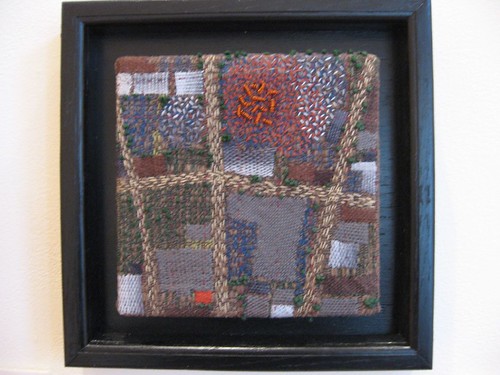
Marie Elcin, Luxury Townhouses Coming Soon
copper and embroidery on cotton
In this nicely mounted exhibit at B-Square of what I take to be local artists (I am familiar with a few of the 10), Marie Elcin once again charmed me with her mix of stitchery, mappery, humor and deadpan-takes on our relationship to Mother Earth.
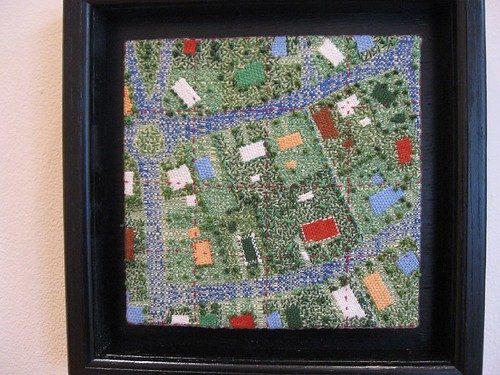

Marie Elcin, Empty Place
embroidery and acrylic on cotton
I was intrigued by Katie Vanvliet‘s use of bb’s in a fiber context:
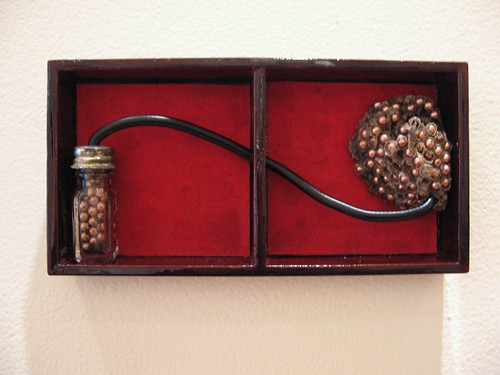
Katie Vanvliet, Ritual Object: Project to get the (b)bees back
wood, cloth, glass rubber, steel, bb’s, wasp’s nest

Kathryn Pannepacker, “and today……”
Hand stitched cloth on wood hoop and wax
And Kathryn Pannepacker‘s quirky diaristic messages in crude embroidery, tempered by a wax coating, amused me for their wiftiness in the choice of words as well as for their execution. The edges on this one must have been singed in honor of the Foreman Grill.
Also in the exhibit, work by June Blumberg, gallery owner Heather Bryson, Julie Dittrich, Karen Henderson, Tara Herberger, Francina Hill, and Francine Strauss.
Showing February 8th – March 26th
B Square Gallery
614 South 9th St
Philadelphia, PA 19147
(215) 625-0692
~Gallery Hours*~
Thursday 1:30 – 7pm
Friday & Saturday 12 – 6pm or call for an appointment
Here’s Part 2 of the fiber posts.




